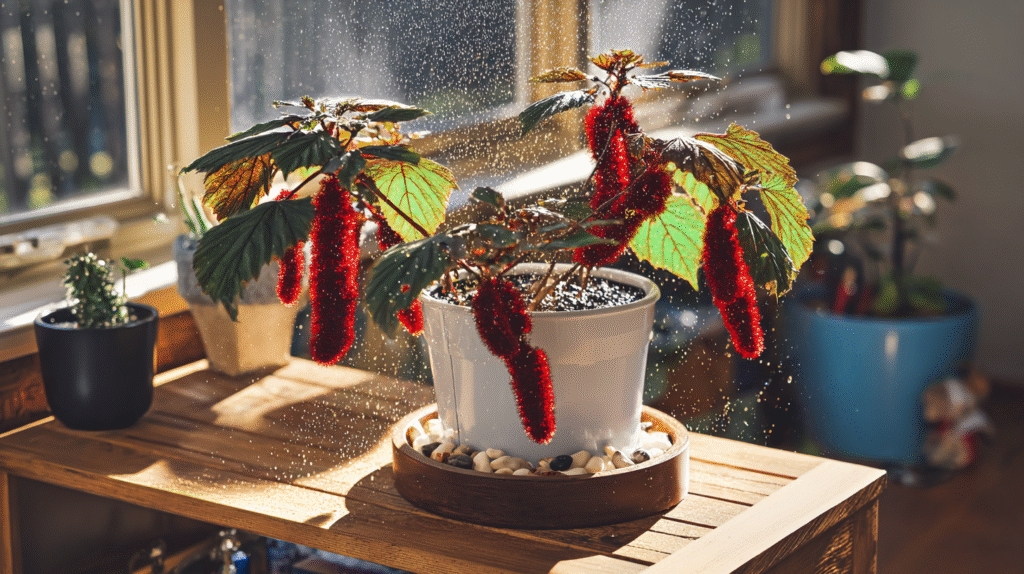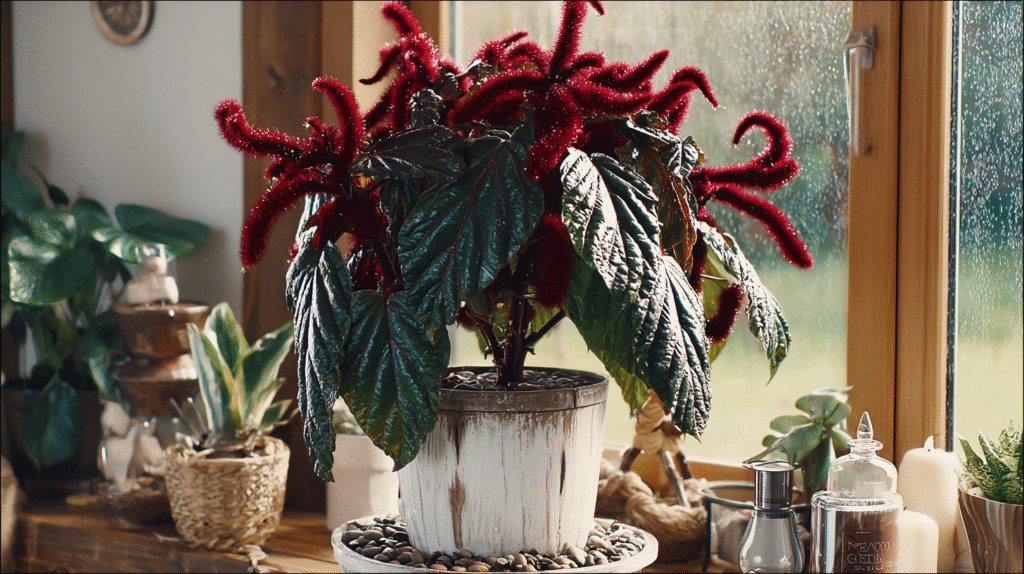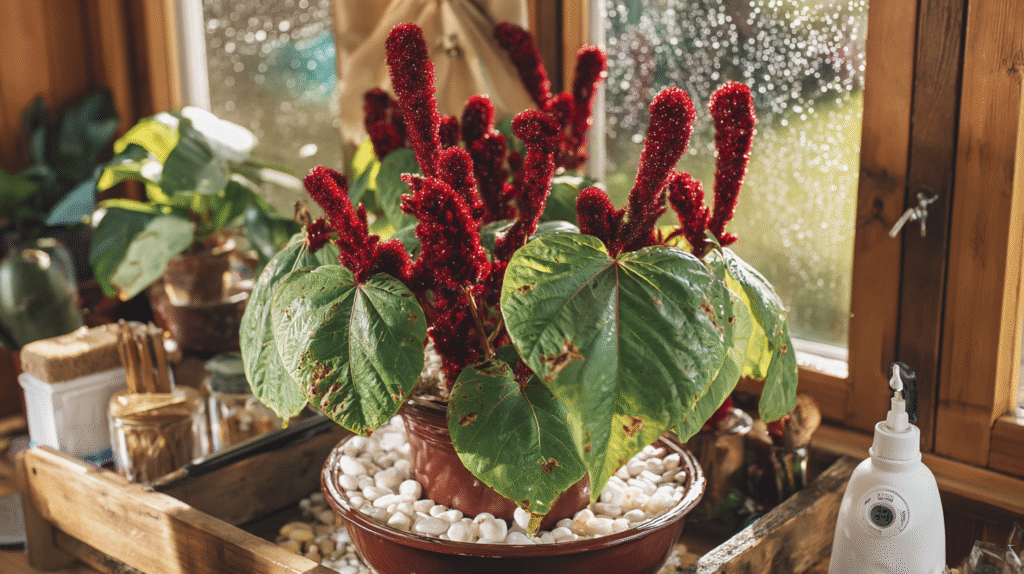Stop struggling with cat tail plant care! Learn from my mistakes and successes with this honest guide to watering, light, humidity, and troubleshooting your Acalypha hispida.
The Cat Tail Plant That Nearly Broke My Spirit
Two summers ago, I walked into my local garden center and fell head over heels for the most unusual plant I’d ever seen. There it was – this gorgeous shrub with fuzzy, bright red tassels that looked exactly like fluffy cat tails swaying in the breeze. The tag said “Acalypha hispida” but everyone just called it the cat tail plant or chenille plant.
“Easy to grow,” the sales associate promised. “Just keep it warm and give it some light.”
Famous last words.
Within three weeks, I was staring at a sad, droopy mess. The beautiful red tassels had turned brown and fallen off. The leaves were yellowing and crispy around the edges. And I felt like the world’s worst plant parent all over again.
But something about those ridiculous, adorable tassels wouldn’t let me give up. After killing two more cat tail plants (yes, I’m that stubborn), I finally cracked the code. Today, my cat tail plant is absolutely thriving – it’s covered in bright red fuzzy flowers and has grown into a gorgeous, full shrub that stops everyone who visits my house.
Here’s everything I wish someone had told me before I started this journey.
What Nobody Tells You About Cat Tail Plants
First things first – these aren’t your typical houseplants. Cat tail plants are tropical shrubs that naturally grow outdoors in warm, humid climates. Bringing one indoors is like asking a beach lover to live in the desert. It’s possible, but you’ve got to work a little harder to make it comfortable.
The fuzzy red tassels that make these plants so irresistible? Those are actually the flowers, and they’re the plant’s way of showing you it’s happy. No tassels usually means something’s wrong with your care routine.
Also, despite what that garden center employee told me, these plants are not low-maintenance. They’re drama queens that will let you know immediately when something’s off. But once you figure out what they want, they’re incredibly rewarding.
Light: Finding the Sweet Spot for Your Cat Tail Plant
This was my first major mistake. I stuck my cat tail plant in a corner with “bright indirect light” like I would with most houseplants. Big mistake.
Cat tail plants want way more light than most indoor plants. Think of them like tomato plants – they need several hours of direct sun to really thrive and produce those gorgeous tassels.
What actually works:
A south-facing window where it gets at least 4-6 hours of direct morning or afternoon sun
An east-facing window if you can supplement with a grow light
Outdoors in a sunny spot during warm months (this is when mine really takes off)
Signs you’re not giving enough light:
No new tassels forming
Leggy, stretched-out growth
Fewer leaves overall
Existing tassels turning brown prematurely
I moved mine to my sunniest window and the difference was incredible. Within two months, it had doubled in size and was covered in new red tassels.
Watering: The Balancing Act That Took Me Forever to Master
Cat tail plants hate being too wet, but they also hate being too dry. It’s like they exist in this tiny sweet spot that I spent months trying to find.
Here’s what finally worked for me:
I water when the top inch of soil feels dry to the touch
I give it a thorough soaking until water drains out the bottom
I empty the drainage tray after about 30 minutes so it’s not sitting in standing water
During summer (when it’s actively growing), this means watering about twice a week
In winter, I back off to once a week or even less
Warning signs I learned to watch for:
Yellow leaves usually mean overwatering
Crispy, brown leaf edges mean underwatering or low humidity
Droopy leaves can mean either – check the soil first
The biggest game-changer was switching to rainwater. My tap water is pretty hard, and I noticed way less leaf browning once I started collecting rainwater for my cat tail plant.
Humidity: The Secret Weapon Most People Ignore

This is where I made my biggest mistake initially. I treated my cat tail plant like a regular houseplant and completely ignored humidity. These plants come from tropical areas where the air is naturally moist, and our dry indoor air is basically torture for them.
What I do now to keep humidity up:
Pebble tray filled with water under the pot (this was a game-changer)
Group it with my other humidity-loving plants
Mist the air around the plant (not the leaves directly) a few times a week
Run a humidifier nearby during winter when the heat’s on
Target humidity level:
Around 50-60% if you can manage it. I bought a cheap humidity meter and was shocked to discover my house was sitting at about 30% during winter.
The pebble tray alone made such a difference. Within a week of setting it up, I noticed the leaf edges weren’t browning anymore and new growth looked much healthier.
Temperature: Keeping Your Tropical Beauty Comfortable
Cat tail plants are basically permanent summer lovers. They want it warm all the time, and they’ll sulk if it gets too cool.
Ideal temperature range:
65-80°F (18-27°C)
What they can’t handle:
Temperatures below 60°F – they’ll drop leaves and stop flowering
Cold drafts from windows or air conditioning
Sudden temperature changes
I learned this lesson when I left mine near a drafty window during a cold snap. It dropped half its leaves in three days. Now I’m much more careful about placement, especially in winter.
Soil and Repotting: Getting the Foundation Right
My first cat tail plant died from root rot because I used regular potting soil that held too much water. These plants need soil that drains really well but still holds some moisture.
My current soil mix:
2 parts good quality potting soil
1 part perlite
1 part coarse sand or pumice
A handful of orchid bark for extra drainage
When to repot:
Every 1-2 years, or when roots start coming out the drainage holes
Best done in spring when the plant’s actively growing
Only go up one pot size – they don’t like being in huge containers
I always use pots with drainage holes. Always. Cat tail plants sitting in waterlogged soil are basically doomed.
Fertilizing: Less Drama Than I Expected
Unlike some of my other plants, cat tail plants aren’t super picky about fertilizer. But they do appreciate regular feeding during their growing season.
My feeding schedule:
Spring and summer: Diluted liquid fertilizer every 2-3 weeks
Fall and winter: Stop fertilizing completely
I use a balanced houseplant fertilizer diluted to half strength. The key is consistency during growing season, then letting the plant rest in winter.
Signs of overfertilizing:
Lots of green growth but no flowers
Salt buildup on the soil surface
Leaf burn or browning
I made this mistake once and got a gorgeous, lush plant with zero tassels. Turns out too much nitrogen encourages leaf growth at the expense of flowers.
Pruning and Maintenance: Keeping It Bushy and Beautiful
Cat tail plants can get leggy if you don’t stay on top of pruning. I was scared to cut mine at first, but regular trimming actually makes them fuller and encourages more tassels.
When and how I prune:
Remove spent tassels as soon as they start looking ratty
Pinch growing tips regularly to encourage bushiness
Do major pruning in early spring before new growth starts
Cut back by about one-third if it’s getting too tall or sparse
The first time I did a major pruning, I was terrified I’d killed it. But within a month, it had exploded with new growth and more tassels than ever.
Common Problems and How I Fixed Them
Brown, crispy leaf edges:
This was my constant problem until I fixed the humidity situation. Pebble trays and regular misting solved it.
No tassels forming:
Usually means not enough light. I had to move mine to my sunniest window to get consistent flowering.
Leaves dropping:
Could be overwatering, underwatering, or temperature stress. Check soil moisture and make sure it’s not near drafts.
Pest problems:
I’ve dealt with spider mites (too dry) and aphids (they love the new growth). Insecticidal soap spray worked for both.
Leggy, sparse growth:
Not enough light and not enough pruning. More sun and regular pinching fixed this.

Seasonal Care: Adjusting Through the Year
Spring:
Time to repot if needed, start regular fertilizing, increase watering as growth picks up
Summer:
Peak growing season – consistent watering, regular feeding, possible move outdoors
Fall:
Start reducing water and fertilizer, bring indoors if it spent summer outside
Winter:
Minimal watering, no fertilizer, watch for dry air problems from heating
The seasonal adjustments made a huge difference. I used to treat my cat tail plant the same year-round and wondered why it struggled.
Is It Worth the Effort?
Look, I won’t lie to you – cat tail plants are more work than a snake plant or pothos. They have opinions about their care, and they’re not shy about expressing them.
But when you walk into a room and see those ridiculous, fluffy red tassels swaying slightly in the breeze from your ceiling fan, it’s absolutely worth it. Mine has become a conversation starter, a mood booster, and honestly, a source of pride.
Plus, once you dial in their care routine, they’re actually pretty predictable. They’ll tell you what they need, and if you listen, they’ll reward you with months of those amazing flowers.
My Final Cat Tail Plant Advice
Start with good light – this is non-negotiable. If you don’t have a sunny window, consider a grow light before you even bring one home.
Invest in a humidity meter and pebble trays. The humidity thing is real, and it makes or breaks success with these plants.
Don’t be afraid to prune. Regular trimming gives you a fuller, more attractive plant with more flowers.
Be patient with the learning curve. It took me three plants and about a year to really understand what mine wanted.
Most importantly, don’t give up after the first setback. These plants are dramatic, but they’re also resilient. With the right care, they’ll give you years of those incredible fuzzy tassels that make everyone smile.

A Quick Note About Pets ⚠️
If you share your home with curious cats or dogs, the cat tail plant might not be the best fit. Acalypha hispida is considered toxic to pets if ingested, and it can cause symptoms like vomiting or mouth irritation. I always recommend double-checking any plant’s safety with your vet—better safe than sorry when it comes to our furry friends!






